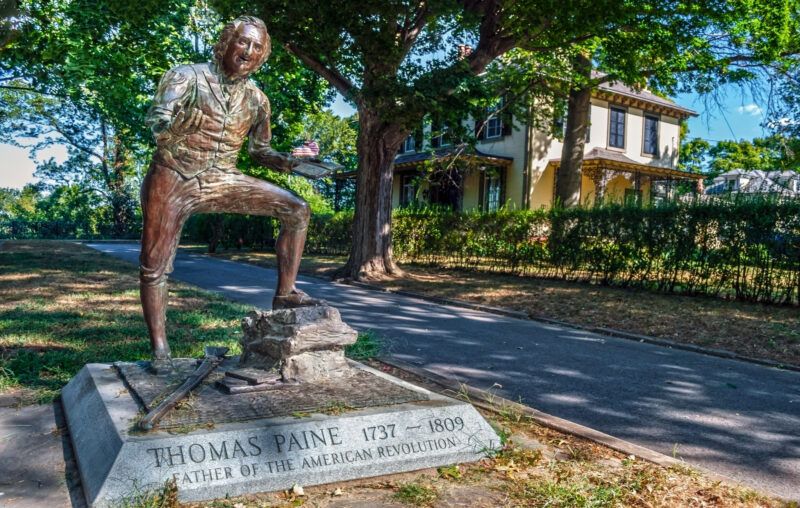No History of Education Vouchers Is Complete without Thomas Paine

Nobody really seems to understand where school choice comes from. On one hand, school choice opponents like the Center for American Progress are willing to butcher the history of the Civil Rights Movement in order to label school choice as racist. On the other hand, school choice supporters tend to credit Nobel-laureate economist Milton Friedman with devising the approach.
Neither is correct.
Of the two, school choice supporters are far closer to the truth. Indeed, Friedman’s landmark 1955 work, “The Role of Government in Education,” certainly helped shape and solidify vouchers as a modern education policy tool. But while Friedman deserves great credit and acclaim for popularizing vouchers, he did not invent them. Neither did John Stuart Mill, the great British liberal of the 19th century who had similar ideas a hundred years before Friedman.
The earliest known fully-fledged voucher proposal dates all the way back to the 18th century, and belongs to none other than the revolutionary American pamphleteer and political theorist Thomas Paine. Unfortunately, Paine’s prickly personality, religious unorthodoxy, and unwillingness to back down from his beliefs caused later scholars to intentionally downplay his contributions. Presently, opponents of school choice try to portray Paine’s voucher idea as little more than a product of 18th-century British politics.
We should avoid making the same mistakes. Paine’s arguments are, indirectly or otherwise, an inspiration for the modern school choice movement, and no history of American education should exclude Paine from its narrative.
While Paine had, at one point, been a tradesman himself, he argued in The Rights of Man that the trades could inhibit the “natural genius” of the individual. This was particularly true in a society and economy like Great Britain, the primary target of The Rights of Man, where a great many families were unable to educate their children at all, much less educate them in a manner that was desirable. Roughly 40 percent of men and 50 percent of women were illiterate, and as much as 75 percent of the population consisted of rural farmers who did not read often.
The targets of Paine’s voucher proposal were farmers, who, while they were not starving, still couldn’t provide their children with an education, which Paine saw as essential to children’s economic vitality. That vitality, in turn, would prevent the rise of monarchy and aristocracy, which were expressions of ignorance and overly concentrated wealth.
The solution, according to Paine, was to “allow for each of those children ten shillings a year for the expense of schooling for six years each, which will give them six months schooling each year, and half a crown a year for paper and spelling books.” Paine’s numbers were based entirely on measurements of British wealth in the late 18th century, but the principle behind the voucher has remained remarkably consistent. The added stipend for spelling books rings of modern education savings accounts, which families can use for far more than private school tuition.
James Stillwagon, a professor of philosophy at Iona College, insists that Paine’s proposal bears no relationship to modern voucher schemes. Paine’s goal, according to Stillwagon, was to ensure a healthy democracy by reducing inequities within social interactions, of which education was and is a part. Stillwagon asserts that Paine would oppose modern voucher programs because they take power away from the government and place it instead in the hands of private entities who have no interest in the common good.
But a response to this argument can be found within Paine’s work. In a footnote to the voucher section in The Rights of Man, Paine noted that “education, to be useful to the poor, should be on the spot, and the best method … to accomplish this is to enable the parents to pay the expenses themselves.”
“There are always persons of both sexes to be found in every village, especially when growing into years, capable of such an undertaking,” Paine added. “Twenty children at ten shillings each (and that not more than six months each year) would be as much as some livings amount to in the remotest parts of England, and there are often distressed clergymen’s widows to whom such an income would be acceptable.” Paine’s argument is essentially a case for private tutors and microschools, which have become popular in the aftermath of the COVID-19 pandemic, and are usually accessible via education savings accounts.
Our collective understanding of the history of school choice is lacking without a chapter on Paine. With Paine in hand, we can conclude that vouchers are neither a modern idea, nor fundamentally racist. When modern school choice advocates claim him as an intellectual forefather, it is not done out of ignorance or out of politically-motivated deception. It is done out of a common desire to use school choice to empower families to advance up the economic ladder.









